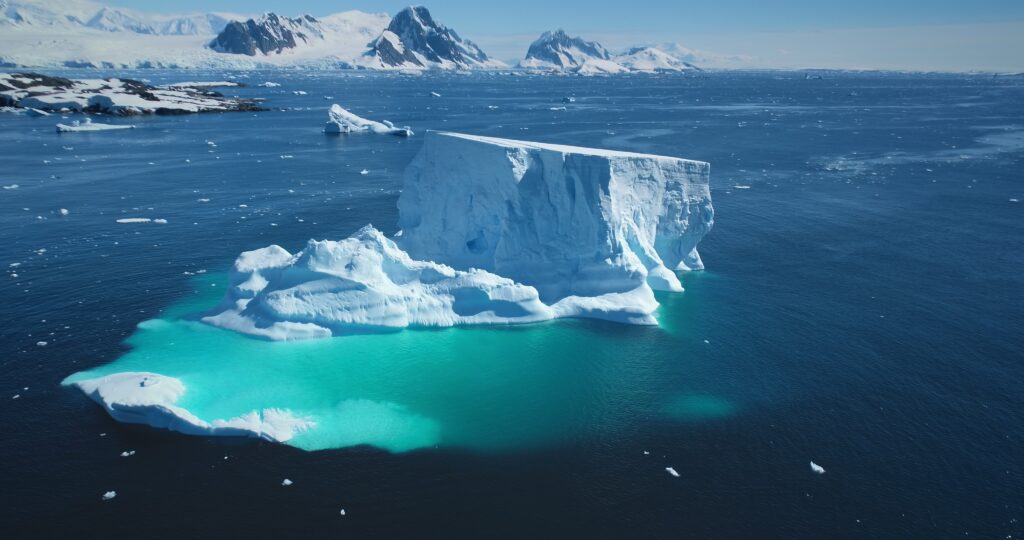In a remarkable discovery, scientists have found that giant icebergs once floated as close as 145 kilometres off the coast of the United Kingdom. These huge slabs of ice were the size of cities like Cambridge or Norwich. They left deep scrape marks on the floor of the North Sea around 18,000 to 20,000 years ago.
The study comes from the British Antarctic Survey (BAS), and it reveals a fascinating glimpse into Earth’s past. It also offers important warnings about what may happen to Antarctica in the future.
Dr. James Kirkham, a marine geophysicist at BAS, said these icebergs were “tabular,” meaning flat-topped, like the ones we see in Antarctica today. They could have stretched for several kilometres and been hundreds of metres thick.
“We think they broke off from large floating ice shelves that once extended from the British and Irish ice sheet,” said Dr. Kirkham. “As these shelves collapsed, the icebergs drifted across the North Sea.”
Hidden Clues Beneath the Sea
The iceberg tracks were discovered in seismic data collected for oil and gas research. These data showed long, straight marks—nicknamed “tramlines”—on the seafloor in a region called the Witch Ground Basin. This area lies between Scotland and Norway.
These long marks could only have been made by very large, heavy icebergs. As they drifted, their massive weight scraped the seabed, leaving scars that are still visible today.
This is not the first time iceberg tracks have been seen in the North Sea. But earlier marks were small and scattered. This new finding is different. It confirms that large, tabular icebergs—similar to those from Antarctica—once floated here.
A Major Shift in Ice History
Dr. Kelly Hogan, a co-author of the study published in Nature Communications, said this discovery marks a major change in Earth’s ice history. Around 18,000 years ago, the large ice shelves holding back the British and Irish ice sheet began to collapse.
When this happened, more icebergs broke off, but they were smaller. This shift from big to small icebergs is a sign that the ice sheet was breaking up quickly. It shows how fast a stable ice shelf can become unstable and disappear.
“It’s like a tipping point,” said Dr. Hogan. “Once the shelves are gone, the glaciers behind them can speed up and retreat faster.”
Lessons for Modern Antarctica
This ancient pattern mirrors what scientists see today in Antarctica. Ice shelves are large floating sheets of ice that hold back glaciers on land. When these shelves are strong, they act like dams, slowing the ice flow into the ocean.
But when they weaken or collapse, glaciers can move much faster. This leads to more ice entering the sea, which raises sea levels worldwide.
In 2002, the Larsen B ice shelf in Antarctica broke apart in just a few weeks. After that, the glaciers behind it sped up by five to eight times their previous pace.
Dr. Rob Larter, another BAS expert, says this ancient data gives us a warning. If Antarctica starts producing fewer large icebergs and more small ones, it might mean a big shift is coming. That would mean more ice loss and faster sea level rise.
A Wake-Up Call for Climate Change
The ancient plough-marks on the seafloor show retreat rates of up to 300 metres per year. That is very fast in terms of ice loss. Scientists worry that parts of Antarctica could soon show the same signs.
Antarctica holds enough ice to raise global sea levels by over 50 metres. Even a small part of that ice melting would cause big problems for coastal cities around the world.
This study helps experts build better models for predicting future changes. By comparing the past with the present, scientists hope to understand how quickly ice sheets can respond to warming temperatures.
The BAS team says we need to watch for signs of change in Antarctica’s iceberg patterns. A rise in small iceberg numbers could signal that ice shelves are weakening.
This discovery from the North Sea is not just about the past. It’s a powerful message about what might happen if we do not address climate change.
As Dr. Kirkham said, “Our planet has seen big ice loss events before, and we’re seeing the signs again. We must learn from the past to protect our future.”


